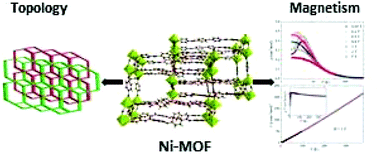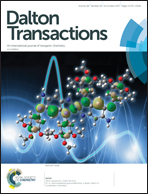Magnetic diversity in three-dimensional two-fold-interpenetrated structures: a story of two compounds†
Abstract
A magnetostructural correlation has been carried out for two newly synthesized two-fold-interpenetrated three-dimensional structures. Compound 1, denoted as [Ni(L1)(L2)]·2DMF (where L1 is 1,4-benzene-dicarboxylic acid (BDC), L2 is 4,4-oxybis-(N-(pyridine-4-yl)benzamide), and DMF is N,N′-dimethylformamide), was observed to have a three-dimensional structure with two-fold interpenetration. Compound 2, denoted as [Co(L3)(L2)]·2DMF (where L3 is 2,5-thiopehene-dicarboxylic acid (TDC)), was also observed to display a three-dimensional structure with an architecture identical to that of compound 1. Both compounds were well characterised using several techniques including single-crystal X-ray diffraction, powder X-ray diffraction, TGA, and IR. Magnetism and specific heat measurements of compound 1 revealed a canted-antiferromagnetic transition at TN ≈ 4 K and a field-induced spin-flop transition at a relatively low field strength. These exotic features were attributed to the low-symmetry space group P(![[1 with combining macron]](https://www.rsc.org/images/entities/char_0031_0304.gif) ) and single-ion anisotropy of the Ni2+ sub-lattice. In contrast, compound 2 was found to be weakly antiferromagnetic in nature with a negligible interaction between the magnetic Co2+ ions.
) and single-ion anisotropy of the Ni2+ sub-lattice. In contrast, compound 2 was found to be weakly antiferromagnetic in nature with a negligible interaction between the magnetic Co2+ ions.



 Please wait while we load your content...
Please wait while we load your content...